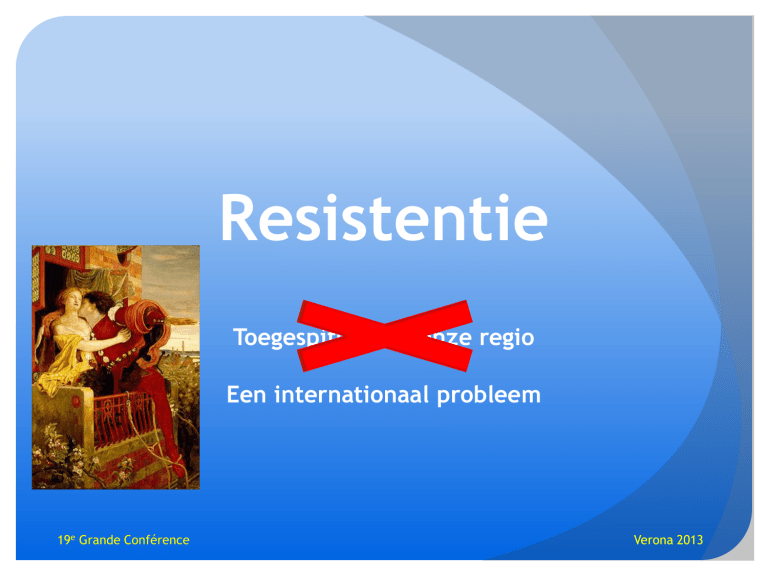
Resistentie
Toegespitst naar onze regio
Een internationaal probleem
19e Grande Conférence
Verona 2013
Indeling bacteriën
Indeling bacteriën
Coccen
Gram positief
Gram negatief
Staphylococcen
Streptococcen
Pneumococ
Enterococcen
Meningococ
Gonococ
Staven
Bacillus
Listeria
Nocardia
E.coli
Salmonella
Shigella
Pseudomonas
Antibiotica klassen
(> 150 preparaten, 64 in FTK)
B-lactam
Quinolonen
Aminoglycosiden
Glycopeptiden
Tetracyclines
Chlooramphenicol
Macroliden/lincosamiden
Sulfonamide
Overige
Werkingsmechanismen van
antibiotica
Celwand synthese
DNA synthese
Eiwit synthese
Resistentie mechanismen van
bacteriën
Veranderd aangrijpingspunt
Verminderde concentratie op plaats van activiteit
Permeabliteit
Efflux
Inactivatie antibioticum
Afbraak
Modificatie
Intrinsieke en verworven
resistentie
Natuurlijke ongevoeligheid
Mycoplasma: beta-lactam R
Gram-positieven: Colistine R
Gram-negativen: Glycopeptide resistent
Natuurlijke (chromosomale) resistentie
K.pneumoniae: AML R
E.cloacae: AMC R
S.maltophilia: Betalactams R
Verworven resistentie
mutatie
DNA acquisitie
DNA acquisitie
Resistentie niet nieuw!!
Selectie van resistentie
Spontane mutatie
Verworven gen
Intrinsiek resistent
tegen antibioticum X
Toedienen
antibioticum X
populatie voor antimicrobiele therapie
populatie tijdens antimicrobiele therapie
Selectie
Resistentie ontwikkeling = selectie
Het toevoegen van een antibiotisch middel
leidt ALTIJD tot selectie van die microben
die resistent zijn voor het betreffende
middel
Hiërarchie beta-lactams
GNS Spectrum
Penicillins
SSP
BSP
ESP
Inhibitors
Cephalosporins
1e
2e
3e
4e
Carbapenems
Klinisch relevante beta-lactamase
houdt tred met introductie van
beta-lactams
Penicilline
Cephalosporine
Carbapenems
Hydrolyse Spectrum
Amoxicilline
penicillinase Gram +ve
klassieke beta-lactamase
(TEM, SHV)
Cephalosporinase
(ESBLs, AmpC)
Carbapenemases
Beta-lactamases
Hiërarchie beta-lactams
GNS Spectrum
Penicillins
SSP
BSP
ESP
Inhibitors
Cephalosporins
1e
2e
3e
4e
Carbapenems
ESBLs
ESBLs: CTX-M-15
Chromosomaal in Kluyvera spp.
Midden ‘90s; Op plasmide in E.coli
Momenteel meest voorkomende ESBL
wereldwijd
70-90% Enterobacteriaceae in India ESBL
Prevalentie elders sterk toenemend
ESBLs in bloedkweken
% ESBL E. coli bloodculture isolates
UMCN
20
18
12
16
10
14
12
8
10
6
8
esbl
4
6
4
2
2
0
0
% ESBL K. pneumoniae
bloodculture isolates UMCN
ESBL Kolonisatie studies
2010: 4,5 % ESBL in opgenomen patiënten
2010: 10,1 % ESBL in patiënten bij huisarts met GI klachten
Landelijk HA ESBL
ESBLs in PAMM regio
2,5%
2,0%
1,5%
1,0%
0,5%
0,0%
2002
2003
E. coli
2004
2005
Klebsiella
PAMM database 2002 t/m oktober 2010
2006
Proteus
2007
2008
Enterobacter
2009
2010
Citrobacter
Co-resistentie ESBL Radboud
Hierarchie beta-lactams
Overige middelen
GNS Spectrum
Penicillins
SSP
BSP
ESP
Inhibitors
Cephalosporins
1e
2e
3e
4e
Carbapenems
ESBLs
Carbapenemases
Carbapenemases
Huidig probleem
Snelle toename MDR/PDR Gram-negatieven
2007
MRSA
G3CRE
C
BSI
27.711
15.183
Excess deaths
5.503
2.712
Excess hospital
days
255.683
120.065
Costs € million
44
18.1
Huidig probleem
Geen nieuwe middelen
Norrby, Lancet Infectious Diseases 2005
Huidig probleem
Geen nieuwe middelen
Snelle toename MDR Gram-negatieven
Huidig probleem
Geen nieuwe middelen
Snelle toename MDR Gram-negatieven
Slechtere uitkomst/toxiciteit
Drijvende krachten resistentie
Toename therapeutisch gebruik totaal
Drijvende krachten resistentie
Resistentie: toename gebruik breedspectrum AB: Vicieuze cirkel
Drijvende krachten resistentie
Niet-therapeutisch gebruik andere sectoren
Outpatient use by pharmacological subgroup
according to ATC classification, year 2008
The European Surveillance of Antimicrobial
Consumption (ESAC)
Drijvende krachten resistentie
Contaminatie omgeving met resistente bacteriën,
genen, en antibiotica
2
1 E. COLI ESBL CTX-M group 1
AEROMONAS spp. ESBL
3
5
4
Drijvende krachten resistentie
Globalisering
Drijvende krachten resistentie
Globalisering met intercontinentale verspreiding
Hierarchie beta-lactams
Overige middelen
GNS Spectrum
Penicillins
SSP
BSP
ESP
Inhibitors
Cephalosporins
1e
2e
3e
4e
Carbapenems
Carbapenemases
OXA-48 carbapenemase
Hoe verder?
Hygiëne
Rationeel antibiotica beleid
Rationeel antibiotica
voorschrijven en preventie
resistentie
Infectie?
Juiste empirie
Klinische DD?
Versmallen
Microbiologische DD?
Tijdig stoppen
Gevoeligheid?
In deze situatie en in
deze patient
Goed doseren
Hygiene
‘Combinatie therapie’
